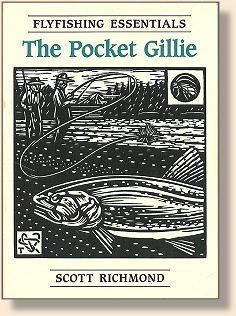|
The Internet is a powerful resource. It provides us instant
access to information, and brings us together via email,
bulletin boards, chat rooms, and instant messaging. FAOL
is a wonderful example of the Internet at its best. The Internet,
however, will never replace the printed page.
I've loved books and fishing since my youngest years, although
I did not start fly fishing until 1993. This column will give
me an opportunity to share reviews of some of my favorite fly
fishing and tying books (and some that are not such favorites)
with my friends here at FAOL. My library reflects my tastes
and interests, and so will this column. It will be heavily
slanted towards cold water fishing and tying for trout and
steelhead, and won't touch much on areas of which I know little,
such as warm or salt water fishing.
I hope that these reviews will motivate some of you to pick up
a good book, on this or any subject, and read.
~ Stu Farnham
The Pocket Gillie: Flyfishing Essentials
 The Pocket Gillie: Flyfishing Essentials
The Pocket Gillie: Flyfishing Essentials
by Scott Richmond
Paperback: 200 pages (November 1992)
Publisher: Four Rivers Press, Lake Oswego, OR
ISBN: 0963306707
Fly fishing author and webmaster Scott Richmond is well
known in the Pacific Northwest, and pretty much unknown
elsewhere. This is no surprise; his website (www.westfly.com)
deals with fishing in the Western U.S., and his books include
titles on Oregon's Rogue River, Crane Prairie reservoir,
Cascade Lakes, and lower Deschutes River. (See the
Great
Rivers series here on FAOL.)
This pocket-sized book deserves to be better known. While
the title might lead one to assume that this is another
book of fly fishing how-to basics, it is instead an attempt
to capture information useful to both novice and experienced
fly fisher in a highly portable pocket format.
"In Scotland and Ireland. . ." Richmond says in his introduction,
"A gillie is a fishing guide. He knows the water and its
inhabitants intimately, and stands by the angler giving
advice on where the best fish are, which fly to use, and
how to present it. This book will serve as such a guide
for you." The rest of the introduction is delightful Scott
talks about how to use the book, the uses and abuses of
generalizations, and pre trip preparation. There's a useful
section of advice to beginners, as well as Richmond's
'Three Never-Fail Rules of Fly Fishing.' My favorite
of these is the corollary to rule #3: "There is no correlation
between the size of the fish and the stupidity of the angler's
technique."
Chapter two, 'Finding the Trout,' reviews the basic needs of
the trout and talks about holding and feeding lies in lakes
and in rivers, where to fish, and how to spot fish.
In chapter three he introduces a key concept that I have not
seen presented so succinctly anywhere else: points of vulnerability,
or POV. These are those stages in an insect's life at which it
is particularly vulnerable to predation by trout. Richmond
uses the POV concept to guide fly selection and presentation
in a set of charts that form the heart of the book. These
charts are grouped by insect order; mayflies are further
split into crawlers, swimmers, and clingers and by the
type of water which they inhabit or in which they emerge.
Each chart lists the genus, species, and common name(s)
of insects in each grouping. It includes fly types and
presentation for the various POVs, size, geographic range
(East, Midwest, West) and time of emergence for insects
in the group. Following the POV charts are hook size charts
detailing the shank lengths of popular hooks in various sizes,
useful to fly tiers in selecting the hook to match a given
insect. There's also a table that attempts to sort out
the mess of common versus scientific names of aquatic insects.
Chapters are included on aquatic entomology, various presentation
techniques, and reading rise forms. The section on identifying
aquatic insects is accompanied by clear ink renderings of aquatic
insects at various stages in the lifecycle, organized as an aid
to identification.
This book has earned a permanent place in a zip lock bag in
the back pocket of my fishing vest. No book of its size can
completely cover the scope of material that Richmond surveys.
However, as a quick reference, introduction, or refreshed,
The Pocket Gillie is invaluable.
~ Stu Farnham
About Stu
 Stu Farnham is a New Englander by birth, who was transplanted to
and put down roots in Oregon in the early 1990s. A software
engineering manager by vocation, he can be found in his spare
time chasing trout and steelhead in the rivers of the Pacific
Northwest, chasing his four Gordon Setters (who in turn are
chasing chukar), tying flies, reading, or working on his website.
Colleen, his long suffering wife of 28 years, is a professionally
trained personal chef.
Stu Farnham is a New Englander by birth, who was transplanted to
and put down roots in Oregon in the early 1990s. A software
engineering manager by vocation, he can be found in his spare
time chasing trout and steelhead in the rivers of the Pacific
Northwest, chasing his four Gordon Setters (who in turn are
chasing chukar), tying flies, reading, or working on his website.
Colleen, his long suffering wife of 28 years, is a professionally
trained personal chef.
|

 The Pocket Gillie: Flyfishing Essentials
The Pocket Gillie: Flyfishing Essentials Stu Farnham is a New Englander by birth, who was transplanted to
and put down roots in Oregon in the early 1990s. A software
engineering manager by vocation, he can be found in his spare
time chasing trout and steelhead in the rivers of the Pacific
Northwest, chasing his four Gordon Setters (who in turn are
chasing chukar), tying flies, reading, or working on his website.
Colleen, his long suffering wife of 28 years, is a professionally
trained personal chef.
Stu Farnham is a New Englander by birth, who was transplanted to
and put down roots in Oregon in the early 1990s. A software
engineering manager by vocation, he can be found in his spare
time chasing trout and steelhead in the rivers of the Pacific
Northwest, chasing his four Gordon Setters (who in turn are
chasing chukar), tying flies, reading, or working on his website.
Colleen, his long suffering wife of 28 years, is a professionally
trained personal chef.